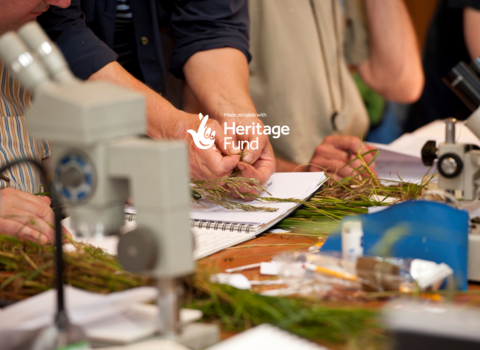Everything you need to know about the #LoveLincsPlants project, funded by the National Lottery Heritage Fund.
What is the LoveLincsPlants project?
Since 2017, the Lincolnshire Wildlife Trust has worked in partnership with the Natural History Museum (NHM) in London, The Lincolnshire Naturalists' Union (LNU), The Sir Joseph Banks Society and the University of Lincoln, to preserve Lincolnshire’s botanical heritage and inspire and train future botanists. The LoveLincsPlants project has helped to preserve over 11,000 historic herbarium specimens while also creating a contemporary herbarium (plant archive) for the county.
The LoveLincsPlants project is supported by the National Lottery Heritage Fund and is now in the legacy phase (2022 - 2026); working to develop the contemporary herbarium and inspire the next generation of botanists.
Why collect plants?
Herbarium specimens are essentially dried pressed plant specimens conserved on archive quality paper and stored in a controlled environment for research purposes. Associated collection data are remarkable and irreplaceable sources of information about plants and the world they inhabit. They provide the comparative material that is essential for studies in taxonomy, conservation biology, biodiversity, ethnobotany, and paleobiology, as well as being used for teaching and by the public. They are a veritable gold mine of information and provide a valuable research tool for investigations into climate change, pollution and habitat change.
What will be collected?
Native and naturalised higher plants will form the majority of the collection and will consist of flowering, seeding or fruiting plants i.e. trees, shrubs, flowering herbs, grasses, sedges and rushes. Depending on project resources, collection of other taxonomic groups i.e. ferns will be included.
Can I collect plants independently for the LoveLincsPlants herbarium project?
No. All volunteers need to be trained in plant collection by attending project training or through volunteering with experienced and trained collectors at organised volunteer groups led by Lincolnshire Wildlife Trust, the Lincolnshire Naturalists’ Union (LNU) or South Lincs Flora Group. This will ensure that specimens are collected correctly for scientific research and to ensure that necessary landowner and site permissions are adhered to.
Is permission to collect plants required from the landowner prior to collecting specimens?
Yes. For the purposes of project we are collecting all parts of a plant specimen, including the roots. Legislation under the Wildlife and Countryside Act (1981) makes it illegal “to uproot any wild plant without permission from the landowner or occupier” in Britain. The term ‘uproot’ is defined as “to dig up or otherwise remove the plant from the land on which it is growing”. Written permission is always secured by project staff and partners prior to collection events and is used as evidence when transferring specimens to the Natural History Museum in London.
Collecting from Sites of Special Scientific Interest (SSSI)
Collecting plants from SSSI sites requires prior consent from the appropriate statutory conservation agencies i.e. Natural England and has been granted for a specific number of sites across the county. Collection on SSSI sites will be carried out in small groups led by experienced botanists according to a detailed strategy developed with Natural England.
SSSIs are recognised as supporting ‘wilder’ plant communities. Collection from SSSI sites will provide a valuable DNA resource for research into population genetics that may influence plant propagation and species and habitat recovery.
Schedule 8 plants
The Wildlife and Countryside Act (1981) includes a list of highly threatened plants that are especially vulnerable to picking. No part of these Schedule 8 species can be intentionally picked or uprooted without a licence from the appropriate statutory conservation agency. These plants are also protected against sale.
The project does not intend to collect Schedule 8 plants and will only collect data and a photographic record for the collection.
Plants of edge of range/low population
In accordance with BSBI guidance (BSBI Code of Conduct 2017), care will be taken when collecting non protected species on the edge of their range or species within a low population to ensure conservation of wild plants. Collection will follow the 1 in 20 rule. If a local population does not meet the minimum threshold i.e. 40 individual specimens need to be present to allow for the collection of 2 medium sized specimens, a photographic record will be taken together with fresh leaf material to form part of a DNA record for the NHM collection.
Volunteering opportunities
Plant collection volunteer
To take part in plant collection, join the Lincolnshire Naturalists’ Union (LNU) on their monthly field meetings where you can volunteer alongside expert botanists and add your name to the contemporary herbarium. To find out more, head to www.lnu.org/meetings/fieldmeetings or email info@lnu.org.
Herbarium volunteer
Contact the Sir Joseph Banks Society in Horncastle to take part in specimen mounting and curation in our new Lincolnshire Herbarium room. Head to www.josephbanks.org.uk or email volunteer@joseph-banks.org.uk for more information.
If you would like to be added to our project events mailing list please email lovelincsplants@gmail.com stating your area of interest e.g. botany ID training, plant collection, herbarium specimen mounting.
Follow us on Twitter for the latest news and events.
Resources
Contact us
Tel: 01507 526667
Email: lovelincsplants@gmail.com

